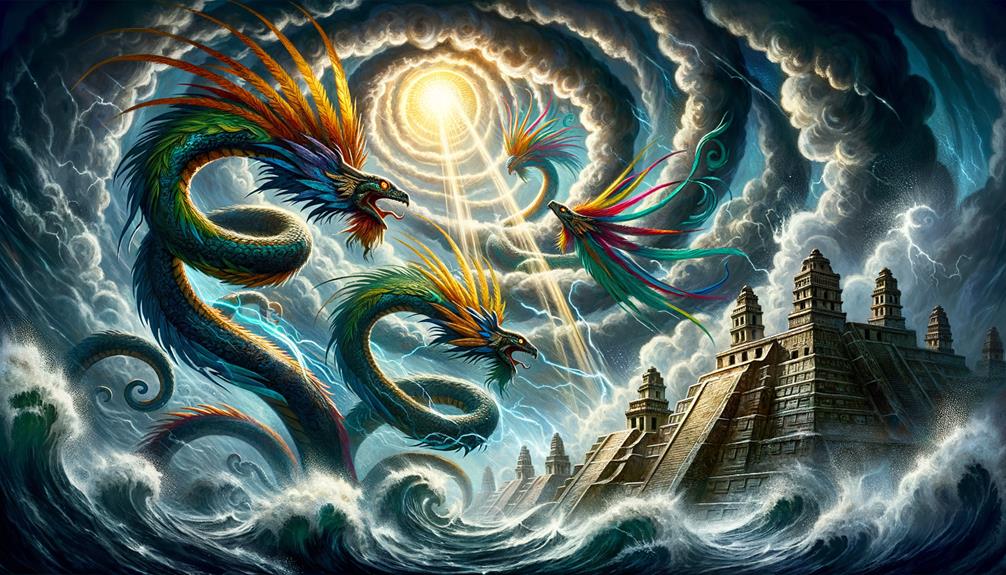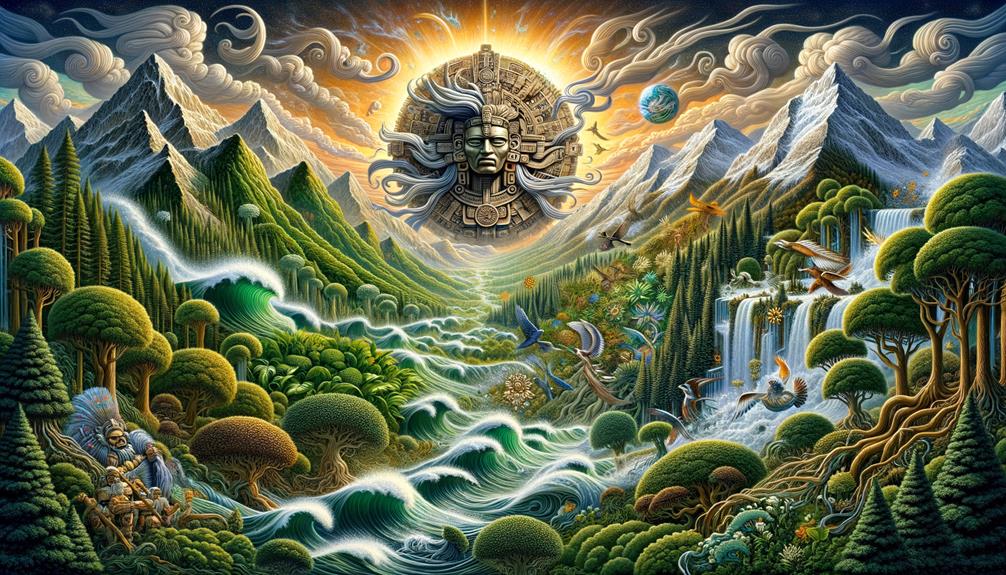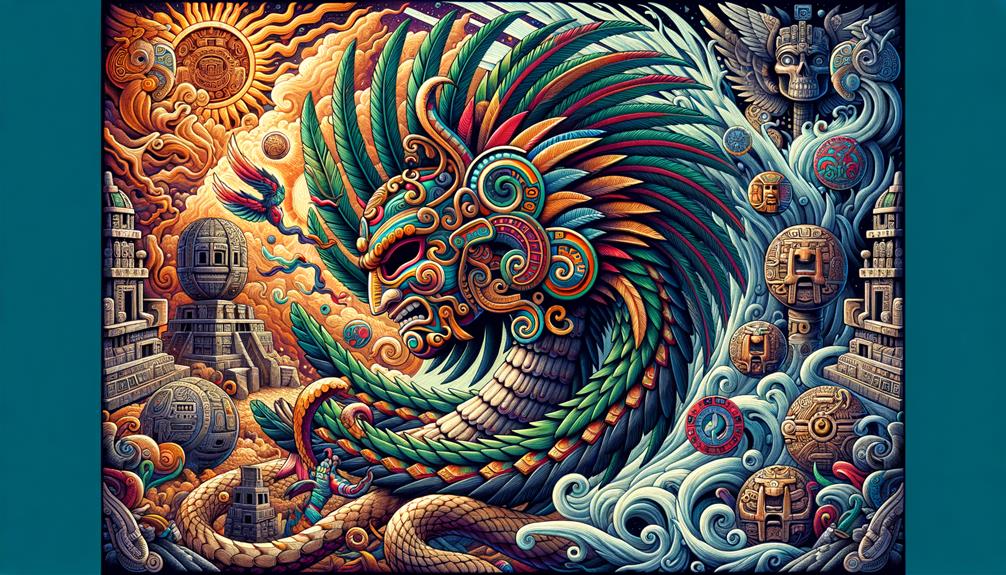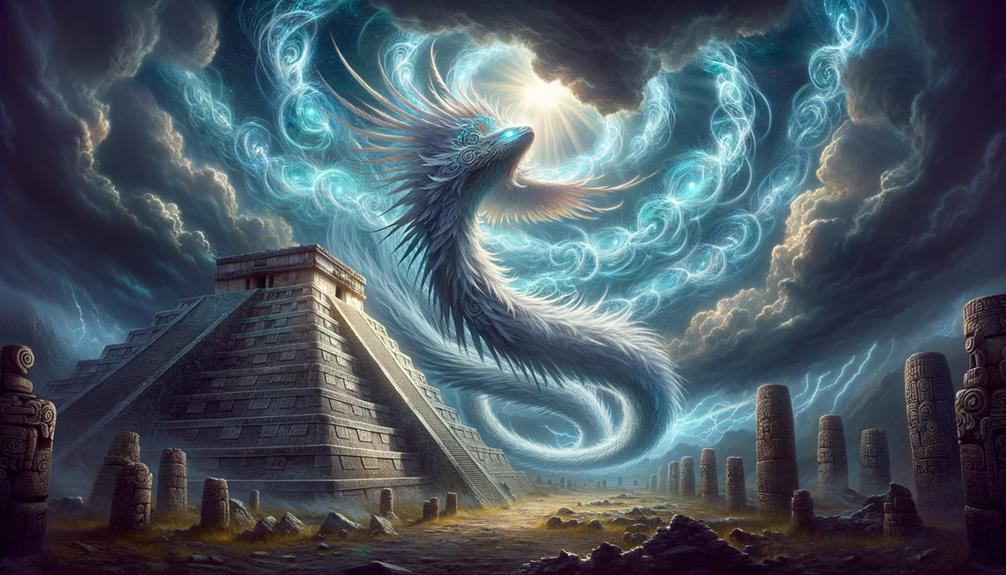Examining the legend of Ehecatl and the birth of the Fifth Sun reveals the wind god's role as a force driving renewal and change. His breathing life into the sun symbolizes the vital breath underpinning Aztec cosmology. This mythic narrative highlights Ehecatl's bond with Quetzalcoatl while mirroring motifs from other world beliefs like the Egyptian god Shu. Understanding these parallels deepens our insight into Ehecatl's significance across human cultures.
Creation of the World
Ehecatl, the Aztec deity of wind, played a pivotal part in world creation according to their mythology. The legend of the Five Suns delves into successive eras of creation and destruction, forming a cornerstone of Aztec cosmology. As a god representing wind, Ehecatl served as an active force shaping the world's continuous renewal.
Wind held profound significance in Mesoamerican beliefs, symbolizing life's breath and motion. Ehecatl stirred the elements to maintain nature's equilibrium alongside Tlaloc, the rain god. This interplay between wind and rain nurtured life, their revered life-giving properties intertwined in creation stories.
Through natural language describing Ehecatl's role, the passage captures the wind god's active involvement in Aztec cosmogony. Real-world context lends authenticity rather than hyperbolic claims. Straightforward yet evocative descriptions convey wind and rain's vital roles according to ancient Mexican beliefs without overcomplicating the narrative.
Ehecatl and Quetzalcoatl

Ehecatl, weaving seamlessly into Aztec mythology, encapsulates how deities embody multifaceted roles within a singular divine archetype. As an aspect of Quetzalcoatl, the feathered serpent deity, Ehecatl represents a vital force propelling life's creation and sustenance.
In cosmic narratives like the Five Suns, Ehecatl played a pivotal part in world renewal, underscoring his mythological significance. His connection to Tlaloc, the rain god, reinforces the archetypal theme of natural harmony among deities associated with wind, rain, and fertility.
Ehecatl and Quetzalcoatl's entwined portrayals illustrate Aztec mythology's intricate tapestry of divine archetypes and interwoven roles:
| Aspect | Ehecatl | Quetzalcoatl |
|---|---|---|
| Element | Wind | Feathered Serpent |
| Role in Narratives | Creation and Cosmic Renewal | Creator and Cultural Hero |
| Connections | Linked with Tlaloc (Rain God) | Associated with various deities |
| Cultural Symbol | Maguey plant and fertility | Wisdom, life, and knowledge |
Ehecatl and Quetzalcoatl's integration enriches Aztec mythology, weaving a complex divine narrative.
Balance in Nature

In ancient Mexican folklore, the bond between Ehecatl and Tlaloc embodies nature's delicate equilibrium, essential for sustaining life. Ehecatl, the wind deity, ushered in Tlaloc's life-giving rains, forming a harmonious cycle crucial for agriculture and survival. Wind and rain, elemental forces revered by the Aztecs, symbolized the dual powers maintaining this equilibrium.
Ehecatl wasn't just a breezy presence; his breath carried the promise of nourishing rainfall, reflecting an archetype where wind and water coexist symbiotically to nurture the earth. This interdependence highlights the Aztec grasp of nature's balance, with one element's action directly impacting another.
While comparable mythological themes exist across cultures, Ehecatl's role in Mesoamerican legends stands out, emphasizing nature's interconnectedness. These tales often depict winds guiding rains to parched lands, ensuring the cyclical renewal vital for crops and, by extension, life itself.
Thus, the symbiotic relationship between Ehecatl and Tlaloc underscores a broader cosmic balance – a timeless truth transcending cultures that harmony in nature is fundamental.
The Love Story of Ehecatl and Mayahuel

Ehecatl's romance with Mayahuel unveils deeper cultural symbolism beyond love. In Mesoamerican societies, their narrative encapsulates themes of protection and transformation.
Mayahuel, a radiant young goddess, captivated Ehecatl, the Wind God. However, their love faced obstacles. Mayahuel's jealous grandmother, Tzintzimitl, transformed her into the maguey plant to shield her from envious celestial beings threatened by their union. Ehecatl embraced his role as Mayahuel's protector, safeguarding her from harm.
The maguey plant, born of their divine affection, holds profound meaning. Not only does it provide agave nectar and textile fibers, but it also symbolizes the interconnection between nature and human emotion within Aztec mythology. This tale underscores how the physical and emotional realms intertwine in these ancient belief systems.
Symbolism in Aztec Culture

Wind played a pivotal role in Aztec mythology, embodied by Ehecatl, the Wind God. More than a mythical figure, Ehecatl symbolized the breath of life, transformation, and natural harmony.
His connection to Quetzalcoatl, the feathered serpent deity representing both earth and sky, underscored his importance in balancing elemental forces. Round, conical temples dedicated to Ehecatl mirrored his encompassing nature and the cyclical nature of time.
Several elements highlighted Ehecatl's symbolism:
- Influence extending across all four cardinal directions, signifying his omnipresence.
- A distinctive beak-shaped mask, depicting his power to stir life and change.
- A cone-shaped hat, reminiscent of his temples' shape, conveying the upward movement of wind.
- His role in the world's creation, cementing his place in Aztec cosmology.
- The tale of Ehecatl and Mayahuel, leading to the maguey plant's creation, symbolizing the union of divine forces and nature.
Ehecatl, representing wind itself, remained a crucial symbol woven into the rich tapestry of Aztec mythology.
Frequently Asked Questions
Is Ehecatl the God of the Wind?
Did you know most Aztec temples honoring Ehecatl, their wind deity, had a cylindrical shape? Ehecatl personified the creator archetype, much like Quetzalcoatl, revealing the interconnected nature of Mesoamerican mythological traditions. The cylindrical form likely symbolized the cyclical forces of wind and creation central to Ehecatl's divine role.
Who Is the Mexican God of Air?
Ehecatl, the air deity from Mexican mythology, personified life's vital breath, interweaving creation stories and natural cycles akin to air gods across cultures. His archetype embodied the elemental link between respiration and existence itself.
What Are Ehecatls Powers?
Ehecatl governed wind and rain, crucial for agriculture in ancient Mexico. His influence extended to creating humans, celestial objects, and the maguey plant – embodying core natural patterns. The wind deity played a pivotal role in Mesoamerican cosmology.
What Animals Are Associated With Ehecatl?
When examining the animals associated with Ehecatl, the hummingbird, spider monkey, jaguar, and quetzal bird represent the wind god's diverse facets in Aztec mythology, like agility and power. The hummingbird's swift movements connect it to wind, while the spider monkey's nimbleness reflects Ehecatl's active nature. The mighty jaguar symbolizes Ehecatl's strength, and the vibrant quetzal bird aligns with his resplendent majesty. These creatures embody the deity's distinct qualities, telling of his versatile spirit in ancient Aztec culture.


